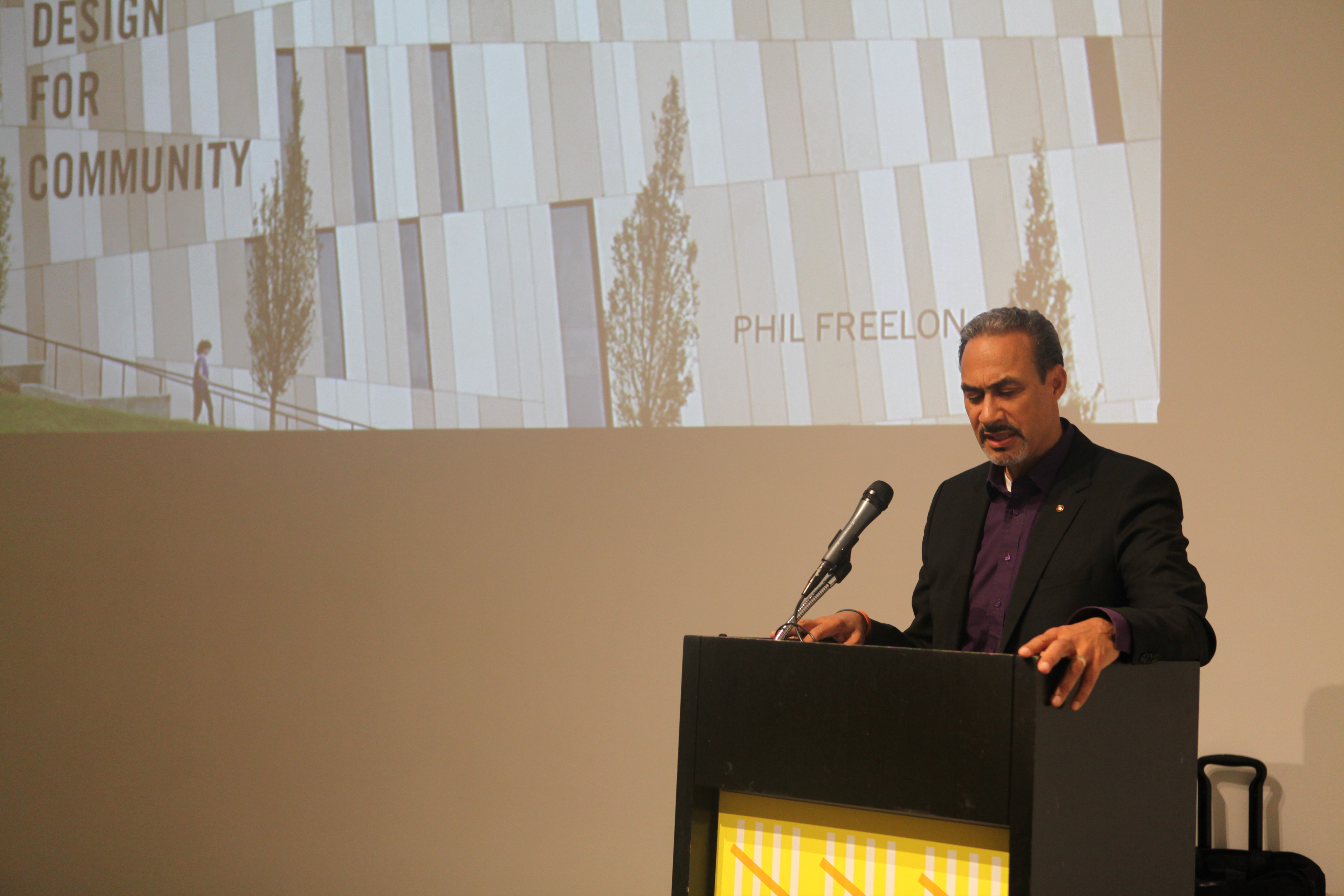by: James Way
The fourth annual J. Max Bond, Jr. Lecture brought esteemed practitioner Phil Freelon, FAIA, NOMA, to the podium. The North Carolina-based architect, who studied how to combine advocacy with practice as a Loeb Fellow at Harvard University, has made a career of designing educational and cultural buildings. Toni Griffin, herself a previous J. Max Bond, Jr. lecturer, introduced Freelon’s talk entitled “Conversations: Community,” reflecting Bond’s own ethos in architecture. The projects that followed certainly promoted cultural and civic understanding, from the historic International Civil Rights Center and Museum in Greensboro, North Carolina, to Freelon’s current collaboration on the National Museum of African American History and Culture for the Smithsonian Institution.
Showing cultural centers, museums, and libraries, Freelon succinctly described each, followed by the design process and realization of the building. He provided status reports of those under construction, such as Houston’s Emancipation Park and the Smithsonian project in Washington, DC. For the latter, Freelon and Max Bond, FAIA, who were separately scouting the upcoming project, decided to pursue the project jointly. Later, David Adjaye, Hon. FAIA, joined the team, , along with Hal Smith, FAIA, of SmithGroup. The Freelon Adjaye Bond/SmithGroup team was a natural, Freelon said, because they all share a similar firm culture. Speaking about the corona topping the Smithsonian design, he declared, “Buildings should be more than just a pretty envelope.” One got the sense that each of his buildings would look good and satisfy deeper design issues.
Two libraries in Washington, DC, demonstrated a design methodology, but not a formula. Both projects examined site and context to yield unique results. One in Tenley-Friendship lifted a sun-shielding wrapper to expose the ground floor, while services lined the solid western wall. The other, in Anacostia, wrapped the sunscreen over pavilions that transitioned the commercial district to the west with the smaller-scale neighborhood to the east. The moves share a common vocabulary, but yield different programmatic and contextual results.
Freelon said the site for the Harvey B. Gantt Center for African-American Arts and Culture in Charlotte, NC, posed one of his more difficult challenges. However, the kernel of the design sprang from the limitations of the 55-foot-wide by 400-foot-long site, which included parking ramp access to an adjacent building. Inspired by stairs in a historical photo and textile patterns, Freelon’s pragmatic planning allowed a poetic response: services along the lengthy party wall, entries at the ends, and public space toward the center, in a dramatic “billboard-like facade.”
However, in discussing the National Center for Civil and Human Rights in Atlanta, Freelon warned, “Things can be trite if you’re too forward in transposing an idea to a building.” The center’s initial concept in 2008 had been interlocking arms, as seen at protest demonstrations. As the decade progressed and budget and square footage decreased by a third, and then a third again, Freelon’s team had to keep tweaking the design. “If you keep shrinking the arms you get a crocodile, or a Tyrannosaurus Rex,” he joked. Ultimately, the project ended up as a pair of “hands” holding an atrium – very different from the initial design, but an expressive public place, nonetheless.
Having started his own firm after completing a “mid-career” Harvard Loeb Fellowship in 1990, Freelon entered a third phase last year, when his firm joined Perkins+Will. When asked what’s next, Freelon easily answered that he is combining his practice’s design and planning prowess with the support of more technical expertise and an expanded geographic network. The profession will certainly be watching.
James Way, Assoc. AIA is Co-chair of the AIANY Marketing and Communications Committee, and a frequent contributor to e-Oculus.
Event: J. Max Bond Jr. Lecture | Conversations: Community with Phil Freelon, FAIA, NOMA
Location: Center for Architecture, 10.26.15
Speaker: Phil Freelon, FAIA, NOMA, Managing and Design Director, Perkins+Will North Carolina; Founder and President, Freelon Group; Toni Griffin, Professor and Director, J. Max Bond Center, Spitzer School of Architecture, City College of New York
Organized by: AIANY Diversity and Inclusion Committee and New York Chapter of the National Organization of Minority Architects (nycobaNOMA)
Sponsored by: Davis Brody Bond










